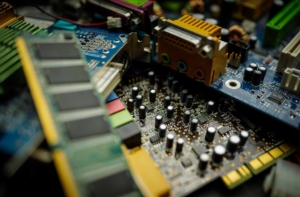Environmental Impact of E-Waste
The Environmental Impact of E-Waste and the Importance of
Proper Recycling
In 2023, the environmental impact of e-waste and the importance of proper recycling are high. E-waste contains hazardous substances like lead, mercury, cadmium, and arsenic, which can have disastrous effects to human health and the environment if not disposed of properly. When e-waste is in landfills, these substances can leak into the soil and groundwater, contaminating the surrounding environment. E-waste also emits greenhouse gasses when incinerated, contributing to climate change.
Proper e-waste recycling is essential to minimizing the environmental impact of electronic devices. It involves separating the different materials in e-waste, such as metals, plastics, and glass, and recovering them for reuse. Recycling certainly reduces the need for new raw materials and energy, conserves natural resources, and decreases greenhouse gas emissions.
Moreover, e-waste recycling can create new job opportunities and boost the economy. It allows for the recovery of valuable metals like gold, silver, and copper, which can be used to make new electronic devices.
E-Waste Recycling: The Facts
To understand the urgent need for proper e-waste recycling, individuals must be aware of global facts. Considering these, anyone should be promoted to start recycling their e-waste accordingly. Some startling facts include:
- The amount of e-waste generated in 2021 was 57.4 Mt (Million Metric Tonnes).
- The total of e-waste is growing by an average of 2 Mt annually.
- Currently, more than 347 Mt of unrecycled e-waste exists on Earth.
- Only 17.4% of e-waste is collected and properly recycled.
- E-waste is the fastest-growing waste stream in the world. According to the United Nations, the world generated 53.6 million metric tonnes of e-waste in 2019.
- In many countries, less than 20% of e-waste is recycled.Hazardous materials can leak into the environment from e-waste when it ends up in landfills.
- The economic value of e-waste is estimated to be around $62.5 billion per year. However, much of this value is lost when e-waste is not properly recycled.
- The global e-waste recycling rate is estimated to be around 17.4%. However, some countries have higher e-waste recycling rates. For example, in 2020, the European Union reported a recycling rate of 42%.
E-Waste: The Approach
To build a more circular economy, businesses in the electronics sector must step up and take responsibility, aside from individuals in the public sector. How individuals and businesses respond to this high environmental impact now will determine the future, our global future. Right now, as it stands, three scenarios could take place.
According to the United Nations Institute for Training and Research, “The business-as-usual ‘linear growth’ scenario — a steady increase of electronics innovation, production, and consumption” will not be free from environmental footprints and toxicity. The institute continues, “In a ‘reactive approach’ scenario — in which the industry will be forced to comply with stricter regulatory obligations — the e-waste situation might improve locally but its impact will be outsourced to countries with weaker environmental regulations.”
Neither of the above provides a great solution. It is, therefore, imperative to follow a third scenario as defined by the institute. “The best alternative will be a ‘proactive path’ to be led by the industry players towards more sustainable production and consumption. Manufacturers can take the initiative with innovative business models, prioritizing lifetime extension and reuse of electronic products. This shift to more circular business practices will reduce the negative impacts of e-waste, despite the inevitable growth in the use of electronics, and also help to prevent e-waste generation.”
E-Waste: Your Action Is Needed
No matter the approach taken by businesses and large corporations, individuals like you can do your part. Fortunately, there are several solutions for getting rid of e-waste responsibly. Some ideas include donating working electronics to charities and nonprofits, finding an e-waste recycling facility, selling the e-waste parts online, and checking to see if local retail stores have e-waste recycling programs.
You can also speak to our team at CheckSammy. We recycle computer monitors and components, smartphones, televisions, video game systems, printers, scanners, cables, circuit boards, DVD/Blu-Ray players, radios, microwaves, dryers, and washing machines.
When you partner with our e-waste recycling services, you’ll receive simple, affordable, tech-forward solutions that bring deep data, peace of mind, and compliance reporting. With the environmental impact of e-waste and the importance of proper recycling high, get in touch with us today: https://checksammy.com/services/sustainability-esg/e-waste-recycling/
See Our Services
Create a custom solution to meet your waste and sustainability goals. Contact us today!
Continue reading
Dive deeper into the CheckSammy Blog by reading one of our posts below
Feeling the Pain of Higher Resident Turnover? Apartment Junk Removal Can Help
If you’re a property manager, you’ve probably had a significant increase in tenant turnover over the last couple of years. So it’s no wonder apartment junk removal may be top of mind for you right now. There are several reasons for this shift. For one, the housing market is on fire right now. In 2020 […]
Read More About Feeling the Pain of Higher Resident Turnover? Apartment Junk Removal Can HelpSetting Up a Community E-waste Recycling Program
E-waste is the fastest-growing municipal waste stream according to the EPA, yet e-waste recycling isn’t keeping pace. In fact, only 12.5% of all e-waste is recycled, reports the EPA. Starting a community e-waste recycling program is a terrific way to ensure hazardous e-waste, like lithium-ion batteries, doesn’t end up in your community’s landfill. Creating an […]
Read More About Setting Up a Community E-waste Recycling ProgramWaste Management’s Role in the Circular Economy
Establishing a waste management program for your business or community is one of the best ways you can contribute to the circular economy. Here’s everything you need to know about waste management’s role in the circular economy (and how to get involved). What Is the Circular Economy? Our current economic model is all about taking […]
Read More About Waste Management’s Role in the Circular Economy5 Reasons to Consider a Textile Recycling Program for Your Organization
Americans sent more than 17 million tons of textiles to landfills in 2018, a volume that is only increasing every year, reports the Environmental Protection Agency. When you think about the fact that it can take over 200 years for textiles to decompose, it’s easy to grasp how large textile waste’s contribution is to the […]
Read More About 5 Reasons to Consider a Textile Recycling Program for Your Organization8 Benefits of Environmentally Friendly Power Washing Services
If you’re into maintaining the curb appeal of your business or home, then you’ve probably heard of pressure washing. Pressure cleaning involves using high-pressure water spray to remove grime, mold, dust, paint, mud, and other junk from objects or surfaces. Many people worry that pressure washing isn’t good for the environment, but this couldn’t be […]
Read More About 8 Benefits of Environmentally Friendly Power Washing ServicesWhy Our Customers Love Our Full-Service Junk Removal
If you’re looking for full-service junk removal services, you’ve come to the right place. CheckSammy is a one-stop shop for all your junk removal and sustainability needs. From our affordability, simplicity, and unrivaled turnaround times to our innovative sustainability solutions and patented technology and data, it’s clear why some of North America’s biggest companies choose […]
Read More About Why Our Customers Love Our Full-Service Junk RemovalTips for a Stress-Free Move From An Eco-Friendly Junk Removal Company
What does an eco-friendly junk removal company know about moving? Quite a lot, actually. Moving can be an especially chaotic time. You have to pack everything up, get rid of unwanted items, clean your property, load everything up, and move your things to your new location. That doesn’t even include the unpacking and resettling period. […]
Read More About Tips for a Stress-Free Move From An Eco-Friendly Junk Removal CompanyCollege Junk Removal Tips for Student Move-In Day
As the new school year gears up, colleges across the country are looking for ways to clean up their campuses before the new year begins, and many of them want to do so sustainably. College junk removal isn’t easy, though, especially around move-in week—and when trying to do so sustainably. As students move in and […]
Read More About College Junk Removal Tips for Student Move-In Day8 Items Hospitality Businesses May Not Know They Can Recycle
One hotel guest produces 2.5 pounds of trash every single day. Just a single hotel room produces around one cubic yard of waste each month, which totals 200 gallons of waste per room every month. Most of this waste goes straight to the landfill, even though research shows that up to 60% of it is […]
Read More About 8 Items Hospitality Businesses May Not Know They Can Recycle












